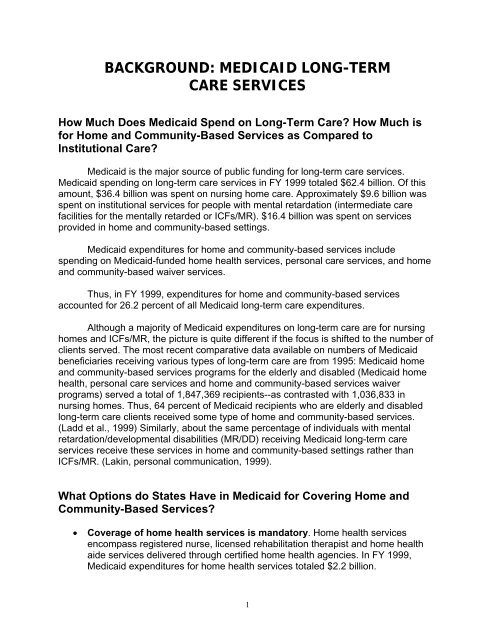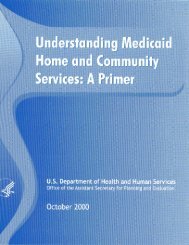Cost-Effectiveness of Home and Community-Based Long-Term Care ...
Cost-Effectiveness of Home and Community-Based Long-Term Care ...
Cost-Effectiveness of Home and Community-Based Long-Term Care ...
Create successful ePaper yourself
Turn your PDF publications into a flip-book with our unique Google optimized e-Paper software.
BACKGROUND: MEDICAID LONG-TERMCARE SERVICESHow Much Does Medicaid Spend on <strong>Long</strong>-<strong>Term</strong> <strong>Care</strong>? How Much isfor <strong>Home</strong> <strong>and</strong> <strong>Community</strong>-<strong>Based</strong> Services as Compared toInstitutional <strong>Care</strong>?Medicaid is the major source <strong>of</strong> public funding for long-term care services.Medicaid spending on long-term care services in FY 1999 totaled $62.4 billion. Of thisamount, $36.4 billion was spent on nursing home care. Approximately $9.6 billion wasspent on institutional services for people with mental retardation (intermediate carefacilities for the mentally retarded or ICFs/MR). $16.4 billion was spent on servicesprovided in home <strong>and</strong> community-based settings.Medicaid expenditures for home <strong>and</strong> community-based services includespending on Medicaid-funded home health services, personal care services, <strong>and</strong> home<strong>and</strong> community-based waiver services.Thus, in FY 1999, expenditures for home <strong>and</strong> community-based servicesaccounted for 26.2 percent <strong>of</strong> all Medicaid long-term care expenditures.Although a majority <strong>of</strong> Medicaid expenditures on long-term care are for nursinghomes <strong>and</strong> ICFs/MR, the picture is quite different if the focus is shifted to the number <strong>of</strong>clients served. The most recent comparative data available on numbers <strong>of</strong> Medicaidbeneficiaries receiving various types <strong>of</strong> long-term care are from 1995: Medicaid home<strong>and</strong> community-based services programs for the elderly <strong>and</strong> disabled (Medicaid homehealth, personal care services <strong>and</strong> home <strong>and</strong> community-based services waiverprograms) served a total <strong>of</strong> 1,847,369 recipients--as contrasted with 1,036,833 innursing homes. Thus, 64 percent <strong>of</strong> Medicaid recipients who are elderly <strong>and</strong> disabledlong-term care clients received some type <strong>of</strong> home <strong>and</strong> community-based services.(Ladd et al., 1999) Similarly, about the same percentage <strong>of</strong> individuals with mentalretardation/developmental disabilities (MR/DD) receiving Medicaid long-term careservices receive these services in home <strong>and</strong> community-based settings rather thanICFs/MR. (Lakin, personal communication, 1999).What Options do States Have in Medicaid for Covering <strong>Home</strong> <strong>and</strong><strong>Community</strong>-<strong>Based</strong> Services?• Coverage <strong>of</strong> home health services is m<strong>and</strong>atory. <strong>Home</strong> health servicesencompass registered nurse, licensed rehabilitation therapist <strong>and</strong> home healthaide services delivered through certified home health agencies. In FY 1999,Medicaid expenditures for home health services totaled $2.2 billion.1
















